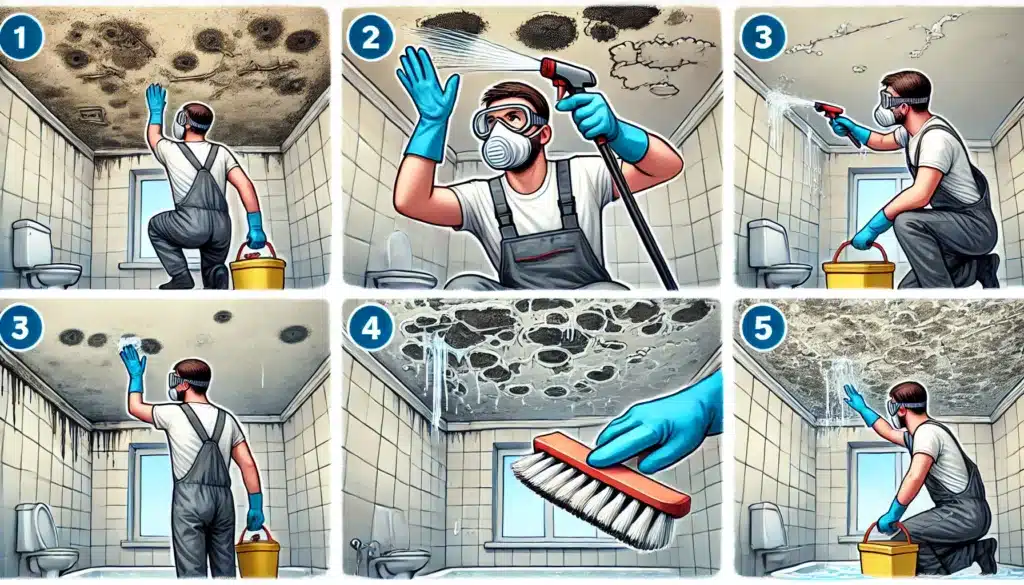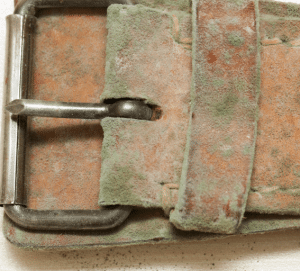Mold on the bathroom ceiling is not just displeasing to look at; it can also pose serious health risks and cause structural damage. Bathrooms in particular are prone to mold growth due to their high humidity and frequent exposure to water.
If you’ve noticed dark patches or a musty smell in your bathroom, it’s likely that mold is already making itself at home. Mold spores thrive in damp environments and can quickly spread if not addressed. This can lead to respiratory issues, allergic reactions, and even more severe health problems if left untreated.
But don’t worry! With the right approach and tools, you can effectively remove bathroom mold and prevent it from coming back.
This guide will walk you through identifying mold, the tools you’ll need, step-by-step instructions for removing mold from different types of ceilings, and tips for preventing mold in the future.
By taking proactive measures and following these detailed instructions, including using mold testing, you can maintain a clean, safe, and healthy bathroom environment. Whether you’re dealing with a small patch of mold or a larger infestation, this guide has you covered.
Signs of Mold on the Bathroom Ceiling
Before diving into removal methods, it’s important to recognize the signs of mold on your bathroom ceiling. Identifying these early can help you address the issue before it worsens.
Common indicators include:
- Discoloration: Look for black, green, or brown spots on the ceiling. These patches can vary in size and often grow over time if not addressed.
- Musty Odor: A persistent musty smell often signals mold presence. If you notice this odor in your bathroom, it’s a strong indicator that mold is growing somewhere in the room.
- Peeling Paint: Mold can cause paint to peel or bubble. This is because mold can weaken the bond between the paint and the surface, leading to visible damage.
- Health Symptoms: Increased allergy or respiratory symptoms when using the bathroom can also indicate mold. Symptoms such as coughing, sneezing, and itchy eyes can be exacerbated by mold spores in the air.
What You’ll Need Before Removing Mold From a Bathroom Ceiling
Before you begin the process of removing mold from your bathroom ceiling, it’s important to gather all the necessary equipment and materials.
Having the right tools and cleaning agents will make the task easier and more effective. Below is a list of the essential items you’ll need.
Equipment / Tools
- Gloves
- N95 mask
- Safety goggles
- Spray bottle
- Soft brush or sponge
- Bucket
- Ladder
Materials
- White vinegar
- Bleach
- Water
- Mold cleaner (optional)
- Baking soda (optional)
Instructions
Removing mold from your bathroom ceiling requires specific steps depending on the type of ceiling you have. Below are detailed instructions for various ceiling types, ensuring that you address mold effectively and safely.
How to Remove Mold on Bathroom Ceilings
Removing mold from your bathroom ceiling is essential for maintaining a healthy home environment. This method is particularly effective for non-tiled bathroom ceilings, such as those made from drywall, plaster, or painted surfaces. Start by preparing a suitable cleaning solution and following these steps to effectively remove mold.
Mix a Cleaning Solution
Begin by mixing a cleaning solution. You can use white vinegar, bleach, or a commercial mold remover. For a bleach solution, mix one cup of bleach with one gallon of water to create an effective mold-killing mixture.
Spray or Wipe on Cleaning Solution
Wear protective gear, including gloves and an N95 mask, to protect yourself from mold spores and chemicals. Use a spray bottle to apply the cleaning solution to the moldy areas. Alternatively, you can wipe the solution with a sponge. Ensure the area is well-ventilated by opening windows or using an exhaust fan.
Check for Stains
After applying the cleaning solution, let it sit for a few minutes to penetrate the mold. Then, scrub the moldy spots with a soft brush or sponge. Check for any remaining stains and repeat the process if necessary to ensure all mold is removed.
How to Remove Mold From a Tiled Bathroom Ceiling
Tiled bathroom ceilings require a slightly different approach to mold removal due to the grout lines where mold can easily hide. This method is particularly effective for ceramic, porcelain, or natural stone tile ceilings. The grout between the tiles can harbor mold, making it necessary to clean thoroughly. Follow these steps for a comprehensive and effective clean.
Mix Bleach and Water
For tiled ceilings, mix one cup of bleach with one gallon of water. This solution helps kill mold and disinfect the tiles.
Saturate the Moldy Areas
Spray the bleach solution onto the moldy tiles, ensuring they are thoroughly saturated. This will help to loosen the mold and make it easier to remove.
Scrub Away the Mold
Use a brush to scrub the tiles, focusing on grout lines where mold often hides. Make sure to scrub thoroughly to remove all traces of mold from the grout.
Rinse and Dry
Rinse the tiles with clean water to remove any bleach residue. Dry them thoroughly with a clean cloth or towel to prevent moisture buildup, which can lead to future mold growth.
How to Remove Mold on a Popcorn Ceiling
Removing mold from a popcorn ceiling requires extra care to avoid damaging the delicate texture. This method is appropriate for ceilings with a textured, popcorn finish, which can be more challenging to clean than flat surfaces. Follow these steps carefully to ensure effective mold removal while preserving the unique ceiling texture.
Mix a Gentle Cleaning Solution
Use a gentle cleaning solution, like a mixture of water and vinegar, to avoid damaging the delicate texture of a popcorn ceiling.
Lightly Dab the Moldy Areas
Use a soft brush to lightly dab the moldy areas without soaking the ceiling. Be gentle to preserve the popcorn texture while effectively cleaning the mold.
Let It Dry Completely
After dabbing the moldy areas, allow the ceiling to dry completely. You may need to repeat the process if necessary, ensuring that the mold is fully removed without damaging the ceiling’s texture.
Types of Mold on Bathroom Ceilings
Several types of mold can grow on bathroom ceilings, including:
- Black Mold (Stachybotrys chartarum): Black mold is toxic and often found in damp areas. It appears as black or dark green patches and can cause serious health issues, including respiratory problems, chronic fatigue, and neurological symptoms.
- Green Mold (Aspergillus): Green mold is common and can cause allergic reactions. It typically appears as greenish patches on damp surfaces and can lead to symptoms such as sneezing, runny nose, and skin rashes.
- White Mold (Penicillium): White mold can cause respiratory issues and is found in damp areas. It often appears as white, powdery patches and can contribute to asthma attacks and other respiratory problems if not addressed promptly.
How to Prevent Mold on Bathroom Ceilings
Prevention is key to keeping your bathroom mold-free. Here are some tips:
- Improve Ventilation: Use exhaust fans during and after showers to reduce humidity. Open windows whenever possible to improve airflow and help dry out the bathroom.
- Fix Leaks Promptly: Repair any leaks from faucets, showerheads, or pipes immediately. Even small leaks can lead to significant moisture buildup, fostering mold growth.
- Dry Surfaces: Wipe down wet surfaces after showers and baths to prevent standing water. This includes walls, ceilings, and floors, which are prone to moisture accumulation.
- Control Humidity: Use a dehumidifier to maintain lower humidity levels in the bathroom. Aim to keep humidity below 60% to deter mold growth.
- Regular Cleaning: Clean the bathroom regularly with mold-preventive solutions. Pay special attention to areas prone to moisture and mold, such as corners, grout lines, and around fixtures. Regular inspections can also help catch mold early.
FAQs
What are the best tools for removing mold from a bathroom ceiling?
Essential tools for removing mold from a bathroom ceiling include a spray bottle to apply cleaning solutions, a soft brush or sponge for scrubbing, and a ladder to safely reach high areas. Protective gear such as gloves, an N95 mask, and goggles are crucial to protect yourself from mold spores and cleaning chemicals. These tools help ensure that you can effectively clean the mold without spreading spores or risking your health.
Can mold damage the structure of my bathroom ceiling?
Yes, mold can significantly weaken the structural integrity of your bathroom ceiling over time. Mold growth can cause materials such as drywall, wood, and plaster to decay and deteriorate, leading to costly repairs and potential safety hazards. By addressing mold growth early and maintaining a dry, well-ventilated bathroom, you can prevent extensive damage and preserve the structural integrity of your home.
Should I use mold-resistant paint after cleaning the ceiling?
Yes, using mold-resistant paint after cleaning the ceiling is highly recommended. These paints contain antimicrobial properties that inhibit mold development, providing an extra layer of protection against future mold growth. Applying mold-resistant paint can help maintain a cleaner, healthier environment by reducing the likelihood of mold spores taking hold again.
Are there natural alternatives to chemical mold removers?
Yes, natural alternatives like white vinegar and baking soda are effective at removing mold. Vinegar kills many types of mold, and baking soda helps to scrub the mold away while deodorizing the area. To use these natural cleaners, mix them with water and apply the solution to the moldy areas, then scrub gently and rinse thoroughly.
End Note
Ensuring your bathroom ceiling is free from mold is crucial for maintaining a healthy and safe home environment. Mold not only affects the appearance of your bathroom but can also pose serious health risks, including respiratory issues and allergic reactions.
Regular inspections are essential; make it a habit to check for signs of mold, such as discoloration, musty odors, and peeling paint.
For a thorough evaluation and peace of mind, consider professional services like Mold Testing Houston. Proper cleaning routines using effective mold-removal solutions will help keep mold under control.





